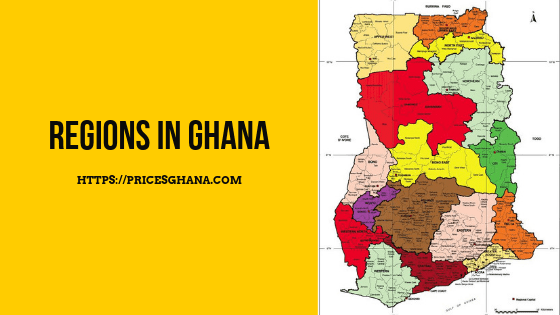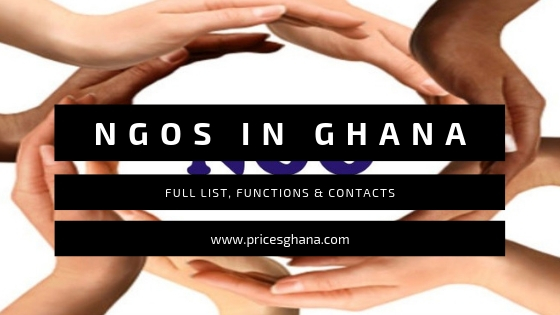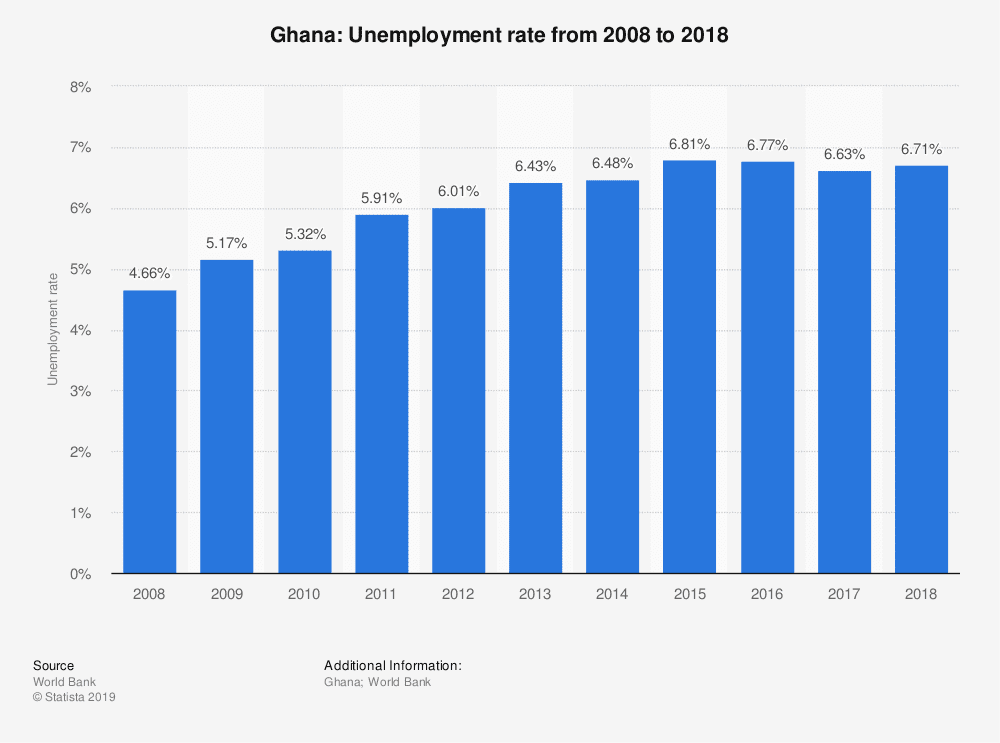Initially, there were only 10 regions in Ghana with each a capital that performs administrative roles in districts within the region. 6 more regions were created out of the original 10 regions in 2018 bringing the number to 16,
The Oti region was created out of the Volta region. The Bono East and Ahafa regions were carved out of the Brong-Ahafo region. The former Brong-Ahafo region was renamed to the Bono Region.
The North East and Savannah regions were created out of the Northern Region. The Western North region was created out of the Western Region.
Regions in Ghana & Their Capitals + Other Details

Below are the Regions in Ghana & Their Capitals + Other Details
1. Ashanti (Capital: Kumasi)
The Ashanti region is the third largest of the 16 administrative regions. However, it is the most populated region with about 5 million people living within the region. The capital of the Ashanti region is Kumasi.
There are several commercial centres, recreation areas, parks, historic sites, and tourist attractions in the region. It is also host to a number of festivals celebrated by the Akan people. The main festivals are the Akwasidae and the Adae Kese.
Kumasi Airport is the main airport in the Ashanti region. It handles most of the domestic flights in the region.
2. Bono Region (Capital: Sunyani)
The Bono Region was previously known as the Brong-Ahafo Region. The Brong-Ahafo region was renamed as a result of the creation of the Bono East and Ahafor regions from it.
The region is located in the southern part of Ghana. Just like the Ashanti region, the Bono Region is known for its large cocoa production. The region is also host to several tourist attractions, parks, and commercial centres.
3. Bono East Region (Capital: Techiman)
The Bono East Region is one of the regions created out of the Brong-Ahafo region. It is part of the vegetative belt of Ghana. This region has one of the lowest population densities.
Most of the people living in the region speak the Bono language, however, the official language of the region is English.
4. Ahafo (Capital: Goaso)
The Ahafo region is among the newly created regions from the Brong-Ahafor region. The region is part of the forest belt of Ghana. It has one of the most fertile soils among the regions.
5. Central (Capital: Cape Coast)
The Central region is one of the original 10 administrative regions of Ghana. This region is also known as a hub of education with many elite higher education institutions being situated within its borders.
This region is well-known for its mining and fishing activities. It heavily relies on industrial minerals and tourism which are the main factors pushing its economy.
6. Eastern (Capital: Koforidua)
Located in south Ghana, the Eastern region is among the original 10 regions in Ghana. It is mostly known for high-capacity electricity generation. The main languages spoken in the region are Akan, Krobo, Ewe, and English.
7. Greater Accra (Capital: Accra)
The Greater Accra region is the second most populated region in Ghana, however, it has the smallest area of all the regions. The area remains the most urbanized region in the country.
The Greater Accra region is a commercial centre. It is also home to many historic sites and tourist attractions. One of its beaches – Labidi Beach, is one of the most popular beaches in Ghana.
There are many other tourist attractions like National monuments, parks, libraries, and festivals that attract tourists to this region.
8. Northern (Capital: Tamale)
The Northern region thrives on agriculture. It was one of the largest regions among the original 10 regions in Ghana until the Savannah and North East regions were carved out of it.
9. Savannah (Capital: Damongo)
The Savannah region is the largest region in the country, however, it has one of the lowest population densities among the regions. It was carved out of the Northern region
The official language spoken in the region is English, but most of the inhabitants speak other languages like Gonja, Mamprusi, Dagbani, or Tamprusi.
10. North East (Capital: Nalerigu)
The North East region is one of the regions created out of the Northern region. The economy of the region is driven mainly by agriculture
It is the site of several tourist attractions like the NaJeringa historic slave wall in Nalerigu, the Buyuori Cave in Yikpabongo, the NaYin Palace in Nalerigu, and the Gambaga Escarpment.
11. Upper East (Capital: Bolgatanga)
The Upper East region is among the 10 original regions in Ghana. It is the second smallest of the regions.
The region has several parks, recreational areas and historic sites that serve as tourist attractions.
12. Upper West (Capital: Wa)
The Upper West region is located in the north-western area of Ghana. Its economy is heavily dependent on agriculture.
Unfortunately, it has a long dry season that doesn’t favor many agricultural practices. This pushes many of its inhabitants to other favorable regions.
13. Volta (Capital: Ho)
The main inhabitants of this region are the Ewe, Guan, and Akan People. The region is divided into 25 administrative districts.
The region features few tourist attractions and recreational areas. It is mostly rural and most of the inhabitants living in rural settlements.
14. Oti (Capital: Dambai)
The Oti region was created out of the Volta region. It is a small region with 8 districts. The main tourist attractions include the Kaybobo National Park and Lake Volta.
15. Western (Capital: Takoradi)
The Western Region was initially a single region until it was divided in 2018. Presently, it is dominated by the Akan people. It features fertile soils and lush green hills.
16. Western North (Capital: Wiawso)
The Western North region was created out of the Western region. The climate of the region is similar to that of the Western region. It features lush green hills and fertile soils.
The region features a high concentration of small and large-scale gold mines companies which drive its economy. Its main tourist attractions are its forest reserves.
Conclusion
The Ashanti and Greater Accra regions remain the most popular regions to tourists. They are also the hub of commercial activities in Ghana which is due to the presence of urban settlements in the regions.
See more on Lifestyles in Ghana.
- Hiking the Kakum National Park Canopy Walkway
- The Top 10 Hair Growth Products in Ghana
- Romantic Gateways for Couples in Ghana 2024
- Best Local Markets for Souvenirs and Authentic Ghanaian Crafts
- List of Traditional Dances in Ghana
- Traditional marriage in Ghana: All you need to know
- The Top 10 Natural Hair Products in Ghana
- Dumbbell Prices in Ghana 2023
- Dentists’ Salary in Ghana: See What They Earn (2023)
- Regions in Ghana & Their Capitals + Other Details
- Top 10 Richest Actors In Ghana (2023)
- Top 5 Richest Women in Ghana (2023)
- Mattress Prices in Ghana (2023)
- Holidays in Ghana 2023
- NGOs In Ghana: Full List, Functions & Contacts (2023)
- Orphanages In Ghana : Full List, Locations & Contacts (2023)
- How to Calculate Electricity Bill in Ghana (2023)
- Sanitation Problems in Ghana & Solutions
- Causes of Teenage Pregnancy in Ghana
- Causes of Unemployment in Ghana & Solutions
- Districts in Accra: The Full List + Details
- University of Ghana Notable Alumni
- Freemason in Ghana: All You Need to Know
- 10 Best Restaurants in Accra
- Ghanaian Fashion Trends for Men And Women
- Ghanaian Music: The Rise of Afrobeat in Ghana
- Traditional Ghanaian Recipes and Cooking Tips
- Ghanaian Proverbs And Their Meanings
- Best Places to Visit in Ghana For Adventure





